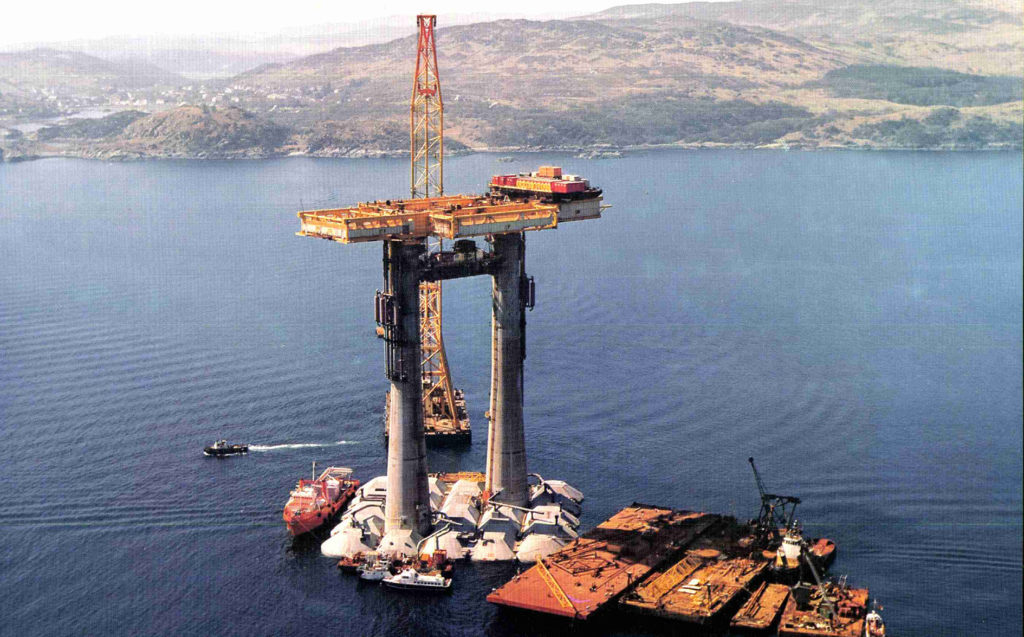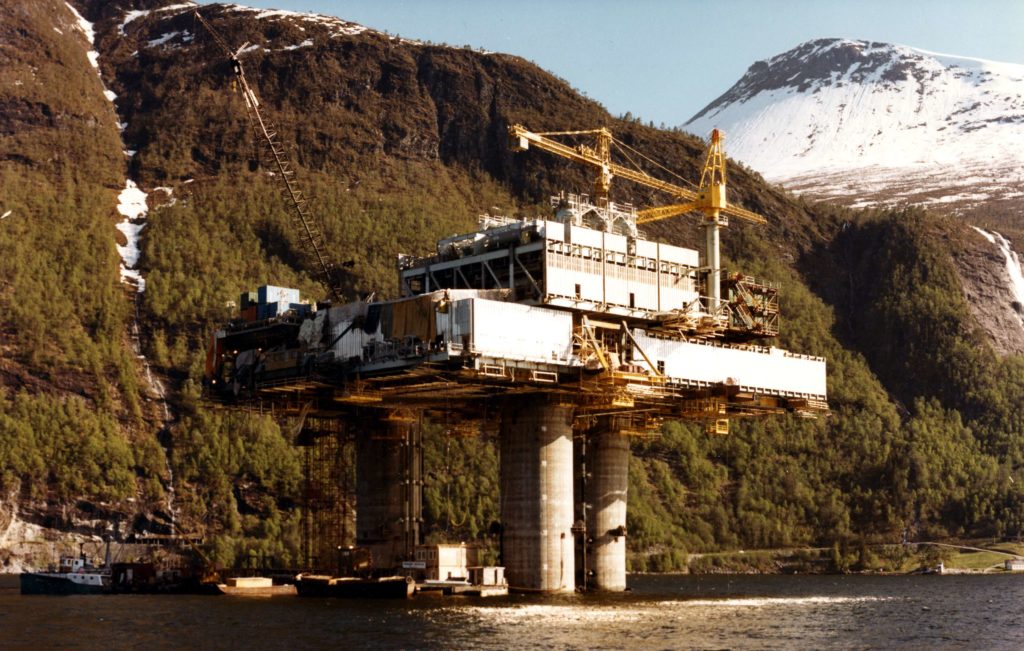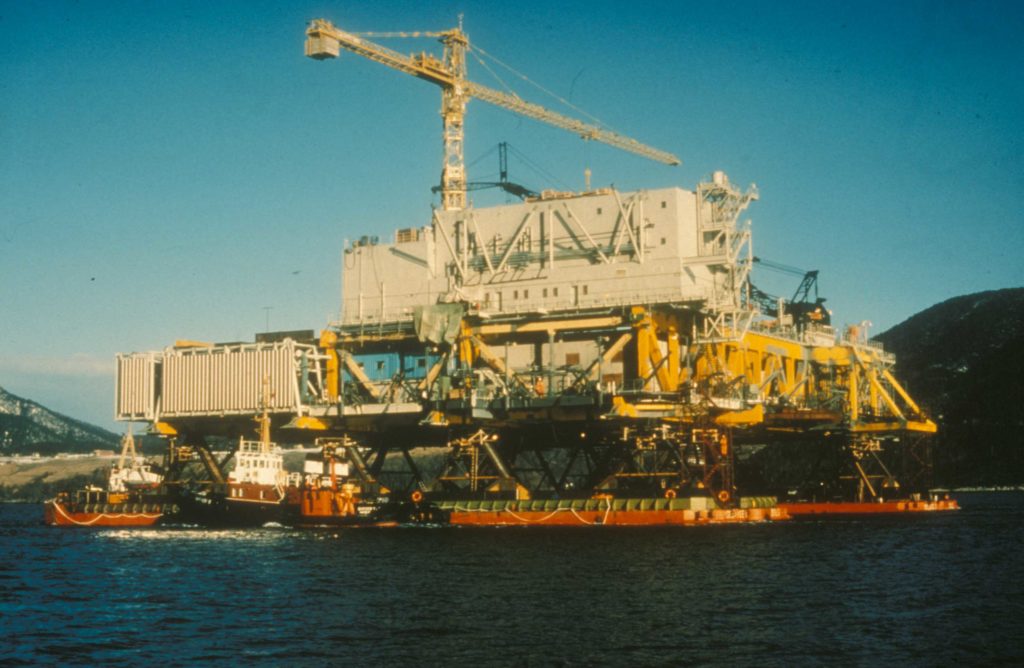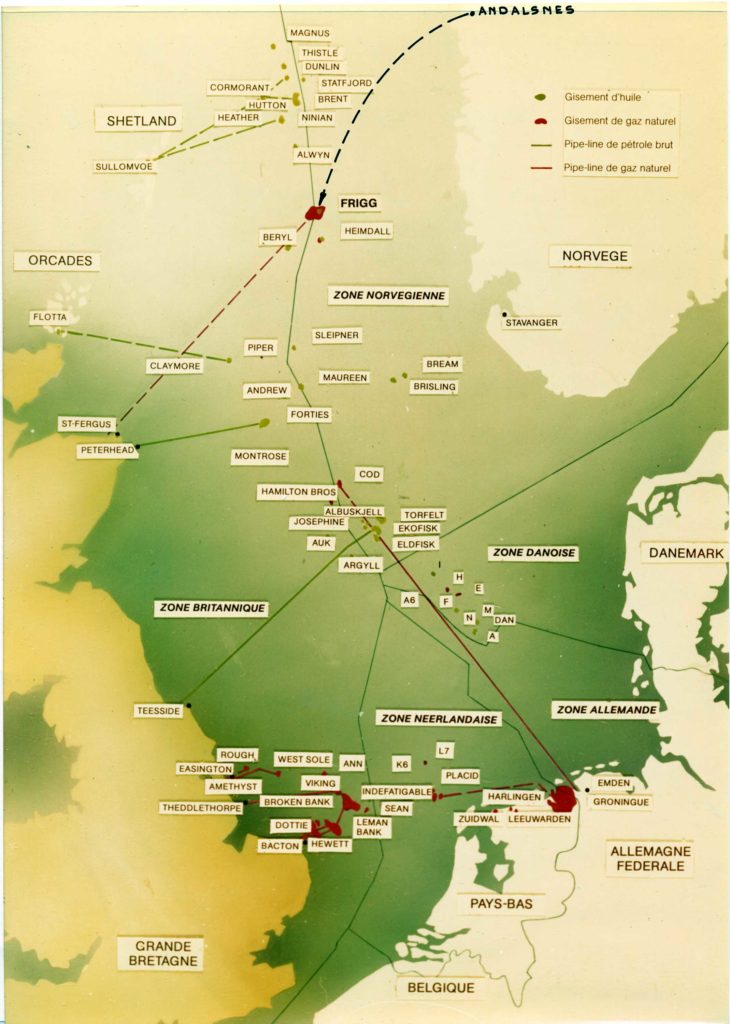Frigg from 1962 to 2004
It shows the development of the Frigg area from year to year.


As a result of mergers, the Total archiveconsists in turn of a number of sections. Many departments and offices have also had separate sets of records. These documents deal not only with Frigg, but also with the company’s ordinary operations. The Eanof archive also comprises several sections – the union’s own correspondence files, materials from the chief safety delegate and the transactions of the working environment committee. Material from Elf Aquitaine Norway is also included, since union representatives sat on the company’s board.
Under a deposition agreement with Total E&P Norge AS, the National Archives in Stavanger has undertaken to store the material even though it formally remains the property of the records creator. Legal rules on confidentiality will be observed, but enquiries about access to and use of the archive will be considered by the company until a possible future amendment to the agreement.
Before the material was sorted, it filled 160 metres of shelving. Rearrangement has reduced this by 50 per cent. The selection aims to document a cross-section of Frigg activities – not only material relating directly to development and operation of the field but also necessary contextual documentation. Space has accordingly been given to land-based operations and general company history. Furthermore, efforts have been made to concentrate on internal company records not found elsewhere. Little of the information reported to the Norwegian authorities (the Norwegian Petroleum Directorate and the ministries) has been conserved by this project. It will nevertheless become lodged with the National Archives’ records when these government document collections are transferred there.
The National Archives has only selected 140 technical drawings produced in connection with the construction and operation of the Frigg field’s installations, a tiny percentage of the total. These include flow diagrams, elevations, deck cross-sections and diagrams of well and piping tracks.
Other sets of records at the National Archives in Stavanger also contain materials dealing with Frigg. The most important are the records of the NPD and the Ministry of Industry’s oil office. The latter embraces material transferred in its time to the NPD and subsequently passed on the National Archives.
Total E&P Norge consisted originally of the Total, Fina and Elf Norge companies. Elf Norge was originally called Petropar A/S from 1965, but changed its name in 1967. Elf Norge became part of Elf Aquitaine Norge A/S in 1977 (previously Sociète Nationale Elf Aquitaine – SNEA). The company changed its name to Elf Petroleum A/S in 1992. Total Norge A/S and Fina Exploration Norge SA merged in 2000. Elf Petroleum also became part of this company in 2001. It was known as TotalFinaElf until 2003, when its official name was changed to Total E&P Norge A/S.
The French company Elf discovered Frigg in block 25/1 in 1971, and became responsible for its development and operation. Frigg ranked at the time as the world’s largest offshore gas field. It straddled the UK-Norwegian boundary line, and accordingly became a collaboration between Britain and Norway (40 per cent UK, 60 per cent Norwegian). The platforms were divided between the two sectors. Plans called for the quarters platform (QP) to stand entirely on the UK side of the boundary, but 10 metres of one corner extended into the Norwegian sector. The two countries nevertheless agreed on a practical boundary midway along the bridge between treatment platform 1 (TP1) and treatment and compression platform 2 (TCP2). A sign on this bridge marked the frontier between Britain and Norway. The boundary provided an opportunity for duty-free sales on QP. TP1, TCP2 and QP collectively formed the core Frigg platforms, also known as the Frigg complex. Drilling platform 2 (DP2) and the flare platform (FP) on the Norwegian side plus concrete drilling platform 1 (CDP1) and manifold compression platform 01 (MCP-01) in the UK sector comprised the remaining Frigg installations. The Frigg area also embraced the North-East Frigg (NEF), East Frigg (EF) and Lille-Frigg (LF) satellites.
Records creator: Pa 1362 – Total E&P Norge
Former names: Elf Aquitaine Norge A/S, Elf Norge. Elf Petroleum Norge A/S, Petropar A/S, TotalFinaElf, TotalFinaElf Exploration Norge A/S
Period: 1967-2007
History: period from 1965 (about) to 2007 (about)
Scope: 80 shelf metres
Access restriction: Restricted private archive, access given to former archive owners.
Description of the archive:
The records have a range of provenances because of all the mergers (see history) and because many offices and departments established their own archives (including two offices when the company was called Elf Norge – one for administration in Oslo and the other for technical activities in Stavanger). Elf Aquitaine Norge created the bulk of the archive, but since no sharp division by periods was made at the time of the mergers, it has been difficult to separate out the Elf records. It is very hard to document the original structure of the archive. Various departments and individuals in Elf have delivered material for which they were responsible, but which they did not necessarily create, to the remote archive. The latter has recorded which department supplied the material. This has often provided the basis for structuring the records into series. Other archives were delivered from the relevant department, which has in turn formed the basis for structuring the series. The material is a selection covering 160 shelf metres (unsorted) made in connection with the Frigg industrial heritage project. This choice was made from several thousand shelf-metres in all. Weight was given to documenting the human side of the activity. The technical/production aspects of the business will largely be documented in the NPD archive. Preserving documents found only in the company’s archive has also been a priority. Information reported to the authorities will be found in the relevant government records. The archive documents not only the Frigg field, which was in operation from 1977-99, but also the company’s regular activities. In this way, activities on Frigg are located in a necessary and broader company context. The series, item and folder descriptions are in both Norwegian and English. The records have largely retained their original titles. Their content is largely in Norwegian and English, but includes some documents in French.
The Elf Aquitaine Norge Offshore Union (Eanof) was established in 1977. It was (and remained in 2007) part of the Norwegian Union of Energy Workers (Safe), previously the Federation of Oil Workers? Trade Unions (OFS) and before that the Union of Operator Employees (OAF).
Records creator: Pa 1415 – Elf Aquitaine Norge Offshore Forening (Eanof)
Period: 1977-2003
Scope: 17.8 shelf metres
Description of the archive:
The records probably have several provenances, because they also contain material from the chief safety delegate (Hovedvernombudet – HVO) and the working environment committee (Arbeidsmiljøutvalg – AMU) in Elf/Total. Eanof officials are likely to have also been represented in the HVO and AMU, or to have received copies of documents within their ambit. Moreover, the achieve includes a number of documents from Elf Aquitaine Norge, including board documents. The union had representatives on the company’s board. As finally organised, the material fills 17.8 shelf metres. The bulk is organised by subject. The correspondence files are organised by file index, and some of the internal memos are arranged in accordance with the National Archives’ own filing system (see the series description).
Bayly started keeping a note book at the end of 1974 initially to assist him in organising his work as the principle structural auditor for the Dunlin A concrete substructure. Initially the note books containing very brief details of events including actions to be taken, facts not to be forgotten, documents received etc. Entries were made as and when necessary and not on a daily basis.
Bayly started keeping a note book at the end of 1974 initially to assist him in organising his work as the principle structural auditor for the Dunlin A concrete substructure. Initially the note books containing very brief details of events including actions to be taken, facts not to be forgotten, documents received etc. Entries were made as and when necessary and not on a daily basis. Over time a more structured approach was adopted and soon entries were made on a regular basis for most working days. The day books, usually referred to throughout his working life as his “Black Books” (although for a period they were red!), include records of conversations, notes taken at meetings, lists of things to do, pasted-in notes from his secretary, details of travel arrangements and, since 1993, details of his working arrangements in Norway. As well as a record of his professional activities the day books also contain a number of entries relating to personnel matters, particularly church activities. The vast majority of the entries in the day books were made at the time the events occurred and no efforts have been made to provide a summary or commentary on the events. The purpose of the day books was to simply record what factual information not to record events for posterity. The primary reason for recording the minutiae of his working life in a day book has not changed since David first started in 1974. The purpose, he says, is “to assist me in effectively organising my work and to provide me with a record of actions, conversations and meetings that might be helpful to me in the future”.
Records creator: David Robert Bayly
Born in Catford in South East London. Father Paul W. Bayly, shipping clerk in a firm of oil and seed brokers, mother Alice Violet Bayly. Family life centred on the local Baptist church. Still actively involved in church life. Education: City University London – BSc (Hons) (1962 – 1966), City University London – PhD (1966 – 1969). Married Doreen Janet Cliffe in 1967, 3 children. Working Background: City University London (1969 – 1971 lecturer in the theory of structures), Pell Frischmann Group (1971 – 1994), Crandon Consultants Ltd (1994 -). Involved in the offshore oil and gas industry since 1973. 1977 to 1993 he was responsible for the technical and commercial management of many design projects including topside modules and decks, steel jackets and subsea production facilities in both the northern and southern basins of the North Sea. He also supervised numerous field development and specialist studies including complex stress analyses of pressure vessels and valves on the Frigg Field platforms. In 1993 he came to Stavanger to assist Elf Norge in the preparation of a safety case for the Frigg Field UK platforms as required by the new UK regulations brought in following the Piper Alpha disaster. He has commuted to Norway on a weekly basis. In 1994 he became an independent consultant working mostly for Elf Norge. 1994 – 1996 he was an “integrated contractor” in the Engineering Department of Elf Norge involved in managing risk analyses for the Frigg Field. In 1997 he moved to the HSEQ Management Department of Elf Norge and was responsible for the preparation of Safety Case submissions to the UK Health and Safety Executive and Applications for Consent to the Petroleum Safety Authority Norway. He has been involved in numerous risk analyses and, since 1999, has been part of the team responsible for the decommissioning of the Frigg Field production facilities.
Those parts of the archive described here were transferred in their time from the Ministry of Industry to the NPD, and subsequently delivered to the National Archives in Stavanger. The rest of the industry ministry?s archive has been delivered to the National Archive in Oslo. The records primarily comprise documents related to the activities of the oil office, but include materials from before the creation of this body ? probably from the continental shelf committee and the State Petroleum Council.
Records creator:
Ministry of Industry, oil office, Ministry of Industry, oil and mining department, oil office.
Period: 1966-1978
History:
As a result of the large increase in oil-related business, it proved necessary in 1966 to establish a separate oil office in the Ministry of Industry. Government consideration of continental shelf issues had previously rested with the ministry’s mining office. A continental shelf committee appointed by the Crown Prince Regent’s decree of 8 November 1963 supported the ministry in preparing legislation and regulations. The State Petroleum Council was established by royal decree of 9 April 1965 to support the ministry as an advisory body concerning exploration for and exploitation of submarine petroleum deposits on the NCS. This council was the licence-awarding authority when blocks were handed out in the first offshore licensing round. The industry ministry acquired its own oil and mining department in 1972. The oil office comprises two sections, for technical and geological aspects respectively. The NPD was also established in 1972.
The archive consists of minutes of meetings, memos and correspondence files. These are arranged in such a way that the original archive structure has been retained ? in other words, it accords systematically with the file index used by the NPD. The NPD?s correspondence files are periodised annually.
All correspondence categories can accordingly be found in each annual set. Records begin in 1973 when the NPD became operational, but some documents from 1972 (the DWP project) are included. The correspondence file contains a general section and a section organised alphabetically by approved discovery and field name and by transport systems. An annual set can cover a large number of boxes. Records which lacked a file code have been organised in series E. See also the A-101348 archive, which contains documents from the Ministry of Industry’s oil office in the 1963-75 period. This material was transferred to the National Archives in Stavanger in 2003.
Records creator: Norwegian Petroleum Directorate
Period: 1972-
History: Legal authority and area of jurisdiction: The Storting (parliament) resolved on 14 June 1972 to establish a petroleum directorate in Stavanger to regulate oil and gas discoveries on the Norwegian continental shelf.
Predecessors: Before the NPD was created, government consideration of continental shelf issues was handled by the mining office of the Ministry of Industry. A continental shelf committee appointed by the Crown Prince Regent’s decree of 8 November 1963 supported the ministry in preparing legislation and regulations. The State Petroleum Council was established by royal decree of 9 April 1965 to support the ministry as an advisory body concerning exploration for and exploitation of submarine petroleum deposits on the NCS. This council was the licence-awarding authority for the first offshore licensing round. A big expansion in the volume of business prompted the creation of a separate oil office in the ministry in 1966, and the latter acquired its own oil and mining department in 1972.
Administrative placement: Petroleum and energy issues were transferred in 1978 from the industry ministry to a new Ministry of Petroleum and Energy. Constitutional responsibility for issues relating to safety, the working environment and emergency preparedness on the NCS was transferred in 1979 from the Ministry of Petroleum and Energy to the Ministry of Labour and Local Government. This meant that the NPD subsequently answered to two ministries. The working environment and safety department of the Ministry of Local and Regional Government was formally transferred to the Ministry of Labour and Government Administration on 1 April 2001. Where carbon dioxide issues are concerned, the NPD derives its authority from the Ministry of Finance.
Functions: The NPD was given overall authority to regulate, carry out total safety assessments for and issue regulations governing the petroleum activity. A branch office was established at Harstad in connection with the start of exploration drilling off northern Norway.
Successors: The NPD was divided into two independent regulatory bodies in 2004: the Petroleum Safety Authority Norway, responsible for safety and the working environment, and the NPD in charge of administering petroleum resources.

From the early 1970s, the Norwegian government was already giving weight to promoting domestic companies as suppliers to the oil industry. Conditions on establishing offices in Norway and the use of Norwegian suppliers were included in the licensing rounds which awarded acreage on the Norwegian continental shelf. While these political guidelines helped to set a more national stamp on the oil industry, the Norwegianisation process took time and did not make itself fully felt until the 1980s.
In the late 1970s, the Frigg development was one of the projects reviewed in a cost analysis of such activity on the NCS. A number of developments had found costs rising sharply compared with initial estimates, and an official inquiry – known as the Moe commission – was appointed to establish the reasons. This body submitted a wide-ranging report in 1980 on progress in the various development projects on the NCS, under the title Cost analysis on the NCS.
| Phase | NOR | FRA | UK | USA | Others |
| Phase I, britisk side 1973-1977 | 17 % | 37 % | 22 % | 16 % | 8 % |
| Phase II, norsk side 1974-1978 | 33 % | 39 % | 7 % | 13 % | 8 % |
| Phase III, compression facilities 1978-1981 | 53 % | 29 % | 6 % | 6 % | 6 % |
| Total distribution | 26 % | 37 % | 15 % | 13 % | 8 % |
Fordeling av Frigg-kontraktene pr. høsten 1978.
Tabell satt opp av Elf til Kostnadsanalysen bind 2, s.104
This report identified a number of factors which could lead to overruns.[REMOVE]Fotnote: Distribution of Frigg contracts to the autumn of 1978. The table was prepared by Elf for the Moe commission’s
report (vol 2, p 104).
One was the country responsible for the delivery, as shown in the table above. Data in the cost analysis showed that about 26 per cent of total deliveries for the Frigg development came from Norway and 37 per cent from France. While the latter accordingly accounted for the biggest share overall, it is worth noting that the Norwegian proportion increased during the development phase.
 TP1 installeres, forsidebilde, historie,
TP1 installeres, forsidebilde, historie,The project was divided into phases. Phase I covered the development of the British share of the field, phase II the work on the Norwegian side, and phase III the installation of the compressors. During phase I and the first part of the second phase, Norwegian involvement was relatively modest apart from local services. One exception was the construction of the concrete gravity base structure (GBS) for the pumping platform, which was later converted to the first drilling installation (CDP1). The GBS was built in Åndalsnes by Norwegian Contractors on behalf of the French Doris group. Suppliers in Norway had an advantage in delivering this type of structure, which called for deep fjords for construction and short distances for towing. A corresponding commitment on the UK side occurred with the construction of Frigg’s TP1 platform in Scotland. The GBS for MCP-01 was built in Sweden because this country had the construction capacity needed.
 Leveranser til utbyggingen, økonomi og samfunn,
Leveranser til utbyggingen, økonomi og samfunn,In phase II, the Norwegian share of orders increased from 17 to 33 per cent, whilst Britain’s proportion sank from 22 to seven per cent. This was primarily because Norwegian Contractors secured the contract to design and construct the GBS and module support frame for the second treatment and compression platform (TCP2). This structure was again built at Åndalsnes. Part of the job of fabricating and hooking up the topside modules went to the Orkanger yard of France’s Spie Batignolles/Vigor. Oil Industry Services in Kristiansand became involved as a sub-contractor at the hook-up stage.
 Leveranser til utbyggingen, økonomi og samfunn,
Leveranser til utbyggingen, økonomi og samfunn,Companies in Norway secured more than half of all the contracts in phase III of the Frigg development, which involved positioning the compressors on TCP2. The Norwegian authorities considered it desirable that Elf placed the order for the compressor modules in Norway, since the domestic share of goods and services for the field was lower than the government expected. In a number of cases, tenders from Norwegian fabricators were uncompetitive.
Because of political pressure, companies in Norway nevertheless won a series of contracts. The largest went to a joint venture between Spie Batignolles and Vigor, with Ponticelli as piping sub-contractor. The generator and process control module was fabricated in Orkanger. By comparison, about half the total deliveries to Statfjord A derived from Norwegian companies. Ten per cent of these contracts were held to have been awarded on a non-commercial basis – in other words, bids from foreign firms were lower than those from Norway, but the latter were preferred to help build up a Norwegian supplies industry.
One purpose of the Moe commission’s analysis was to investigate whether the purchase of Norwegian goods and services was responsible for the cost increase. The study found that the rise in costs from using domestic suppliers was not especially great in relation to total expenditure. In the autumn of 1978, the development project was estimated to have cost NOK 10.5 billion. That represents an increase of NOK 7.6 billion from the 1974 forecast of NOK 2.9 billion, or more than a tripling. No less than NOK 1.2 billion of this rise related to the loss of the DP1 jacket. The additional cost of using Norwegian deliveries was put at NOK 50 million, since bids from domestic fabricators were often higher than those from foreign suppliers. According to the report, the bulk of the overruns was attributable to expensive technical solutions, often in combination with the use of consultants and weak control by the operator. Prices had also been driven up because a number of large development projects were being pursued at the same time.
 Leveranser til utbyggingen, økonomi og samfunn,
Leveranser til utbyggingen, økonomi og samfunn,The additional cost of using Norwegian suppliers was small by comparison with the total overruns in the Frigg development. Many had feared that political pressure to “buy Norwegian” would lead to sharp cost increases, but these worries proved misplaced. The deadline-based contract for gas deliveries meant that progress was prioritised at the expense of cost control. Delays arising from the loss of the DP1 jacket could be recovered to some extent with deliveries from Norway. The Frigg project was implemented at a time of very strong price inflation for oil industry supplies. It also proved difficult to cost the new technical solutions which were adopted.
Sources:
Moe, Johannes (ed): Kostnadsanalyse norsk kontinentalsokkel (Cost analysis for the NCS), 1981.
NOU 1999, 11: Analyse av investeringsutviklingen på kontinentalsokkelen (Analysis of investment development on the continental shelf).